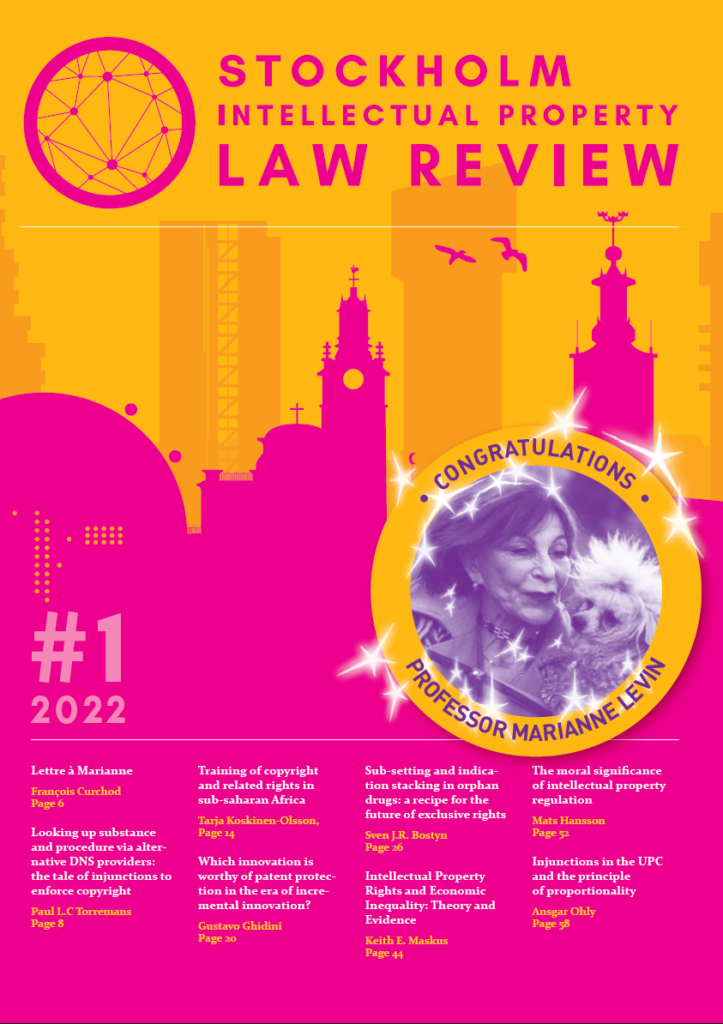
STOCKHOLM INTELLECTUAL PROPERTY LAW REVIEW
Åsa Hellstadius & Frantzeska Papadopoulou
Editorial
The Stockholm Intellectual Property Law Review was established within the auspices of the Master’s Programme of European Intellectual Property Law at Stockholm University – a programme that was initiated by Professor Marianne Levin and welcomed its first students in early January 2000. The students came from different parts of the world, and the lectures would usually take place at the picturesque wooden house ‘Juristernas Hus’ (‘The Law Student’s House’) on the Stockholm University campus. In particular for international students adjusting to the extremely cold winter of 2000, getting acquainted with the Swedish university system and its pedagogical approach was a challenge. However, what warmed up the environment was the feeling that you had actually been welcomed into a ‘family’ of IP enthusiasts, a ‘family’ led by the fashionable and renowned IP connoisseur Marianne Levin, with the assistance of her doctoral candidates. This feeling, which is really very difficult to describe on paper, followed you throughout the studies, and afterwards – even after graduation – you continued to be part of the alumni network of the programme.
It is characteristic that among the group of Master’s students of this first year, two eventually went on to write doctoral dissertations in IP at Stockholm University. In 2000, European IP law was in a state of transformation. The advent of the internet in the 1990s profoundly changed the way in which we communicate, use and share information and intellectual resources. In 1994, the TRIPS agreement fuelled the globalisation of IP and recognised the need for global cooperation in the field of minimum standards for protection and sanctions. Sweden’s accession to the European Union in 1995 marked the entrance of Swedish IP law into the European Union legal framework, including its IP regulations, and ended the national (and Nordic) exceptionalism in that sector. It was in this environment that the Master’s programme was born.
The creation of the Master’s programme seemed like a natural expansion of the vibrant research and teaching environment that Marianne Levin had created at the Department of Law at Stockholm University. In the early 2000s, her research group consisted of around ten doctoral candidates, but it would gradually expand even further. The group covered a broad spectrum of IP law and marketing law, e.g., likelihood of confusion and protection of reputation in trademark law, unconventional trademarks, copyright and databases, consumer protection and trading law, employees’ IP rights, patents and biotechnology, damages in patent law and protection for traditional knowledge and natural resources.
Marianne nurtured the research endeavours of her doctoral candidates and the hub that she created was unique in its diversity and scope. It was an unrivalled achievement. It was only natural that the Master’s programme grew out of this unique environment, with plentiful resources for teaching and a strong connection between research and teaching. Beyond resources from the internal research group at Stockholm University, the teachers, examiners and supervisors engaged in the Master’s programme were part of Marianne’s international research network. These were colleagues from Denmark, Finland, Norway, Germany, France, the US and other countries, who enhanced the teaching staff as guest lecturers. This amazing international network of prominent researchers would gather in Stockholm, even in the cold winter months, to deliver lectures, supervise students and discuss the prospect of new research projects with Marianne and the doctoral candidates.
The IP Nordic Network was actively involved in this initiative, and the programme included several teachers and students from other Nordic countries. Marianne has always been able to identify future IP talents and either attract them to the university to pursue an academic career or encourage them to work at law firms or companies. She has in that way gradually built up a network of IP professionals who owe her their inspiration and interest in IP. Further, it has always been amazing to watch how she is able to enchant and engage students in her projects, activities and competitions, whether IP-related or not. The programme is a result of Marianne’s devotion to developing the field of IP law by recognising and supporting young students with a passion for that field. Her network of former students and amanuenses comprises private practitioners, professors, company lawyers, CEOs, ministry officials and others – in Sweden and internationally.
Such has been the impact of the programme that the alumni network now stretches to all parts of the world (perhaps excluding Antarctica?). Even while juggling the position of a professor and expert with many projects and responsibilities, including as Chair of the Swedish Association for Intellectual Property Law (SFIR), guiding junior researchers in the field of IP law has always been one of Marianne’s passions and an influential part of her legacy. Marianne continues to work as a teacher within the Master’s programme and the undergraduate law programme, and many young IP law students still benefit from her advice and support. She also actively supports the work of the Stockholm IP Law Review! Our warmest congratulations to Marianne on her birthday – and we are looking forward to many more!
Åsa Hellstadius & Frantzeska Papadopoulou
Lettre à Marianne
By François Curchod
ABSTRACT
Très chère Marianne, si je t’écris cette lettre en français, ce n’est pas seulement parce que nous conversons de temps à autre dans la langue de Molière, mais c’est aussi et surtout parce que le français est ma langue maternelle, donc la langue du coeur. Et c’est mon coeur autant que mon cerveau qui dicte mes mots aujourd’hui.
Looking up substance and procedure via alternative DNS providers the tale of injunctions to enforce copyright
By Prof. Dr. Paul L.C Torremans
INTRODUCTION
The request to contribute to an issue to celebrate the work of Marianne Levin brought back plenty of nice memories. I had the pleasure of knowing Marianne for many years and I remember with pleasure those sessions I taught in Stockholm with Marianne and her dog in the back of the room. And when they took place on a Saturday her father would come along too and on a couple of occasions we ended up lunching on pizza at Pic-Nic on campus. Later on, we did our EU funded project on human embryonic stem cells and on one occasion Marianne chaired a meeting from campus whilst I was stuck on a plane that had diverted to Gothenburg because the radar at Arlanda Airport had gone down. With the doors of the plane open I could join the meeting via mobile and when I finally hurried in by taxi from Bromma Airport the draft we had been discussing was all ready and merely needed proofreading.
Training of copyright and related rights in sub-saharan Africa
By Tarja Koskinen-Olsson
INTRODUCTION
Training of intellectual property rights has been close to the heart of Professor Marianne Levin and she has been a Master Trainer, welcoming participants from all corners of the world. This is why I have chosen the topic of training for my article, congratulating her on her anniversary. Understanding how international copyright law and realities on the ground affect the functioning of the copyright market in a given country or region, offers a possibility to review and evaluate developments.
Which innovation is worthy of patent protection in the era of incremental innovation?
By Gustavo Ghidini
ABSTRACT
Long, long “gone are the days” of the XIX parameter of a ‘flash of genius’ to define the qualitative level of an innovation deserving of a patent. That parameter went out, as known, due to the evolution of modern R&D dynamics, chiefly consisting (unlike the groundbreaking ones of the first industrial revolution) in painstaking processes made up of progressive even small but quite costly steps carried on by trial and error (J. Reichman) by complex teams of specialist researchers, working with sophisticate computing and scientific equipment.
Sub-setting and indication stacking in orphan drugs: a recipe for the future of exclusive rights
By Sven J.R. Bostyn
INTRODUCTION
The present article is, apart from the result of my own work and intellectual effort, also written for a special occasion. Professor Marianne Levin has turned a healthy age, and I have been asked by the current esteemed colleagues at the Stockholm Law Faculty to write a contribution for this special occasion. Scheduling this piece of work into my calendar was difficult, due to a list of other commitments, but I could not possibly refuse the honour, so I accepted. The reader might wonder how Professor Marianne Levin and I could possibly be linked.
Intellectual Property Rights and Economic Inequality: Theory and Evidence
By Professor Keith E. Maskus
INTRODUCTION
I am pleased to be able to contribute to the special issue honoring Professor Marianne Levin. Marianne has long been a global leader in the legal analysis of intellectual property (IP) policy and has particularly been concerned with various socioeconomic ramifications of IP rights (IPRs). In that spirit, I offer this piece on a deeply important yet understudied aspect of IPRs: how do such rights interact with economic inequality, within and across nations? This complex question only recently has begun attracting attention by economists, despite massive concerns over growing inequality and its potential effects. In this paper I review the limited, yet substantive, theoretical and empirical studies of this issue. My objective is to explain how economists think about it, noting, for example, that there could be two-way causal impacts between IPRs and inequality.
The moral significance of intellectual property regulation
By Professor Mats Hansson
ABSTRACT
Fundamental ethical principles provide guidance for the protection and wider use of intellectual achievements. As regarding established rules for claims of authorship in scientific publications, use of intellectual property is not a matter of providing an open unregulated access but to honor the intellectual achievements while providing an avenue to wide application for promotion of innovation to the benefit of society. This is done through a balancing of different interests. In this article I examine some of the basic principles for this balancing task. A special concern in the discussion about intellectual property regulation has been the need to fit new scientific and technical innovations within the changing moral landscapes of different countries. Innovations must not offend what is considered “public order”. I put this claim into perspective by demonstrating that this value laden concept needs to be adjusted in accordance to changing moral landscapes that often follow when new innovations become part of main stream technology and provide significant benefits.
Injunctions in the UPC and the principle of proportionality
By Prof. Dr. Ansgar Ohly
INTRODUCTION
The way towards a European patent judiciary is best characterised by the title of a Beatles song: it has been “a long and winding road”. But after many proposals, initiatives and setbacks the Unified Patent Court now finally seems to become reality. The tricky issue of whether the UK could still participate even after Brexit has been solved – in a very unfortunate way, but it has been solved. The constitutional challenge in Germany has made a new implementation in the German Parliament necessary, but the new implementing act reached the necessary two-third majority, and the German Federal Constitutional Court has recently refused to accept a constitutional complaint against the new implementation. The UPC Agreement (hereinafter UPCA) has now reached the stage of provisional application. Germany is acting as a gatekeeper and will deposit its ratification once the preparations have been finalised.
